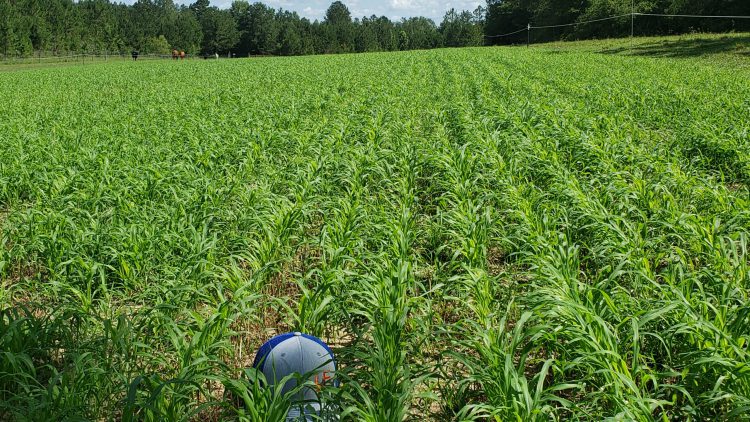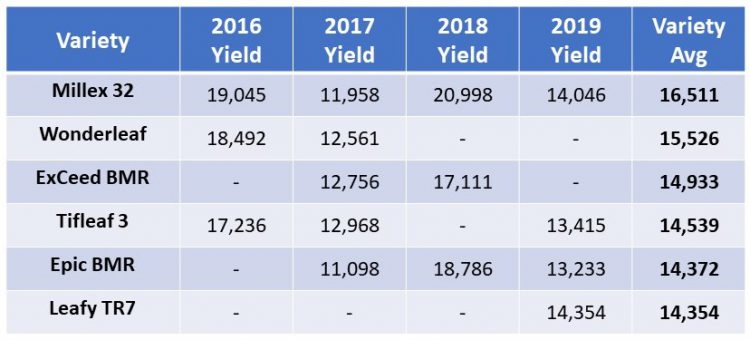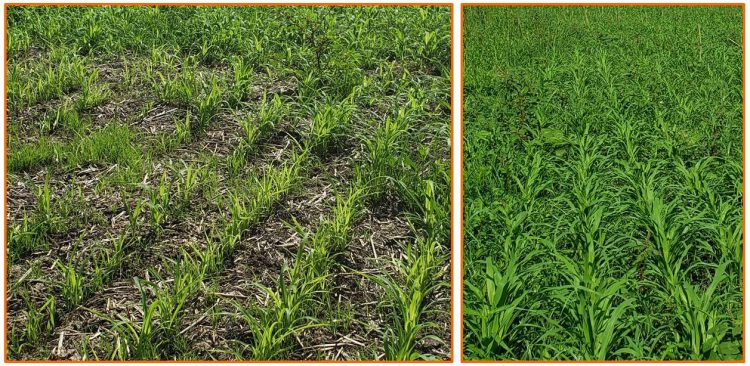
Pearl millet planted behind ryegrass in Washington County. The picture was taken 14 days after planting. The millet is approximately 3 weeks away from being tall enough to graze. Photo Credit: Mark Mauldin, UF/IFAS
Pearl millet (Pennisetum glaucum) is certainly not new on the scene, and while it is widely used on stocker operations and dairies, it has been my observation that this fast growing, high quality, summer annual grass is somewhat under utilized on cow-calf operations. Pearl millet can be used as a hay or silage crop, however, the following is a discussion of how it could be more fully utilized for grazing on cow-calf operations.
Granted, there are periods during a mature cow’s production cycle where the nutritional quality of pearl millet exceeds her requirements. In my opinion, this and the “something else to do” factor, associated with planting annual forages are why pearl millet is not more widely utilized on cow-calf operations. There’s not much to be said or done about the “something else to do” factor, but when the nutritional situation is more closely examined, it becomes evident that the nutrient content provided by (well managed) pearl millet are quite appropriate for a brood cow throughout much of her annual production cycle (Figure 1). Additionally, when compared to bahiagrass (the most common alternative), pearl millet would have much more capacity to help cows that have lost body condition “turn around” in a timely manner.

Figure 1. Percent TDN requirements by month for a 1,200lb “medium” milk cow. Well managed pearl millet should be approximately 55% TDN and 12% CP. The highlighted figures represent months where the cow would require the level of TDN provided by pearl millet. 12% CP would exceed the cow’s requirement throughout the production cycle. Source: Basic Nutrient Requirements of Beef Cows.
–
There are several other scenarios where grazing pearl millet fits in well with management of a cow-calf operation. In several of the following situations, growing high quality millet can provide cost savings as compared to purchasing off-farm feed.
- Developing replacement heifers
- Providing the extra nutrition needed to help first calf heifers breed back in a timely manner
- Creep grazing nursing calves
- Grazing weaned calves during preconditioning
From a land use perspective, pearl millet is an excellent crop option following cool season annual forages (small grains and ryegrass), since there is no overlap in the seasonality of the two. Pearl millet likes warm conditions, minimum soil temperature above 64°F, and minimum air temperatures above 50°F. Air temperatures in the mid-90s are optimum for growth. Pearl millet planted shortly after cool season forages play out in the late spring will stop growing before the earliest recommended cool season forage planting (Oats – September 15). Setting aside a portion of the ranch exclusively for annual forages on a prepared seed bed (not over-seeded on perennial pasture) allows for earlier, faster establishment of cool-season forages. Utilizing pearl millet on this same ground can dramatically increase the annual production per acre – pearl millet can produce very impressive forage yields (figure 2).

Figure 2. Dry matter tons per acre yields for selected pearl millet varieties. Yield data sourced from the UGA State Wide Variety Testing program.
–
Pearl millet can also be very useful for pasture renovation projects. When trying to renovate a perennial pasture heavily infested with smutgrass, centipede, or some other unwanted grasses, it is generally advisable to spray non-selective herbicides multiple times. In most renovation scenarios, annual grasses are utilized to some extent. While cool-season annuals planted after a fall herbicide application is the most common scenario, following that system with another herbicide application and planting pearl millet keeps the pasture being renovated productive all year long, and the seasonality of the two crops (discussed above) aligns perfectly with the most effective times of year to chemically control unwanted perennial grasses.
Planting pearl millet in areas heavily damaged by winter feeding may also be worth considering. The soil is already “prepared” in hay feeding areas. Pearl Millet can generally be easily established in these otherwise unproductive weed beds (figure 3), after burning off thick hay residue and perhaps some leveling. Even if a perfect stand is not achieved, the millet allows you to take advantage of all the nutrients deposited over the winter, and make that area productive through the summer. Hopefully, you don’t have large areas heavily damaged from hay feeding, so these small areas can become paddocks that can work quite nicely for creep crazing using temporary fencing.

Figure 3. Pearl millet drilled into a field heavily damaged by hay feeding last summer with no soil preparation or weed control. While this is not ideal and will negatively impact days from planting to grazing height and total production, it is still likely that the millet will eventually shade out most of the weeds and produce an appreciable amount of forage in this otherwise wasted area and capture nutrients deposited over the winter. * In all establishment scenarios, weeds present at planting time should be controlled. Like all seedlings, pearl millet establishes best with minimal competition (left). Under acceptable conditions pearl millet grows very rapidly, so most weeds that germinate after the millet is established are quickly shaded out (right). Photo Credit: Mark Mauldin, UF/IFAS
–
Pearl Millet Quick Facts
- Pearl millet can tolerate drought, sandy soil, and moderately acidic soils. It will not tolerate standing water.
- Select dwarf type varieties for grazing situations.
- Seeding rate recommendations vary somewhat. ± 15 lbs./ac drilled or 30 lbs./ac broadcast.
- Seeds should be planted ½” to no more than 1” deep.
- Pearl millet should be allowed to grow to approximately 24” tall before grazing. Grazing to lower than 8” can greatly slow regrowth or cause plant death.
- Prussic Acid poising is not a concern with pearl millet, but nitrate accumulation can be an issue
- Fall Armyworms and other foliage feeding caterpillars can severely damage pearl millet during the growth stage, so don’t forget to check planted fields periodically.
–
Pearl millet is not new, and chances are if you’ve been in the cow business very long you have some experience with it. With that in mind, every spring/summer when I see how fast pearl millet germinates and grows, and how well cattle do on it, I am perplexed why more of it is not utilized on cow-calf operations. Take a moment and consider if incorporating pearl millet into your current forage system could benefit your operation. If you have any questions about where or how to utilize pearl millet, don’t hesitate to contact your county’s UF/IFAS Agricultural Extension Agent.
–
More Information on Pearl Millet
Pearl Millet: Overview and Management
Pearl Millet: Georgia Forages
Establishment of Warm Season Annual Grasses
Producing Millets and Sorghums
Pearl Millet: NRCS Plant Guide
- Peanut Maturity Update – 10/9/25 - October 10, 2025
- Fall Can be a Great Time for Vegetation Management - October 3, 2025
- Peanut Maturity Update – 9/25/25 Edition - September 26, 2025
